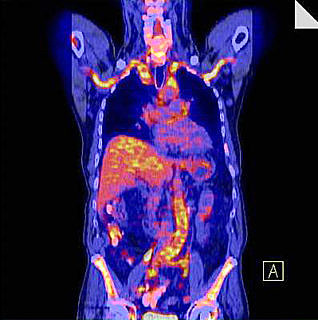Faster apprehension of fever causes

New strategy discovered for diagnosis of unexplained fever and elevated inflammation levels with PET-CT
Fever can be a symptom of a cold, or the warning sign of a serious illness. If the fever lasts longer than three weeks or recurs repeatedly with no apparent cause, medical practitioners refer to it as ‘fever of unknown origin’. Increased inflammation levels can also have an unknown origin. In both cases one thing is clear: the cause must be identified. Since these symptoms could have more serious causes, such as autoimmune diseases, infections or even tumours, time is of the essence in their diagnosis. An interdisciplinary team of physicians from the Department of Medicine 3 – Rheumatology and Immunology and the Department of Nuclear Medicine at Universitätsklinikum Erlangen has now developed a strategy for faster diagnosis. This new procedure has been published in the specialist international journal “Annals of the Rheumatic Diseases” (2016; 75: 158-159).
Case A: Temperature of 38.5 degrees over several weeks – no-one knows what is causing the fever and why the treatments applied so far are not working. Case B: Sustained elevated inflammation levels in the blood – with no obvious cause, despite extensive tests. The possible causes are many and varied: hidden infections such as tuberculosis, inflammation of the blood vessel walls as found in immune system diseases, malignant mutations such as lymph node cancer, or genetic febrile illnesses. A rapid and accurate diagnosis is therefore often life saving in cases of prolonged fever. ‘Every patient with fever or unexplained elevated inflammation levels must be examined individually like in a criminal investigation,’ says Prof. Dr. Bernhard Manger, attending physician of Medicine 3, describing the initial problem. ‘Our job is to profile the suspect, identify them and then take preventative action.’
Earlier scans with PET-CT
The largest international investigation to date into improving the diagnosis of unidentified fever has been carried out by research teams from Medicine 3 and Nuclear Medicine at Universitätsklinikum Erlangen. In the study, patients with raised temperatures and inflammation of unknown origin received an early whole-body scan with positron-emission tomography/computer tomography (PET-CT), which was performed in addition to the standard tests. ‘This technique allows us to image pathogenic metabolic processes in the body, and perform an accurate analysis of the tissue structure,’ explains Prof. Kuwert. ‘This means we can discover hidden inflammations, infections or even tumours.’
The results of these investigations show that the early application of a PET-CT scan can improve diagnosis in cases of unexplained fever and inflammation and more importantly, speed it up. ‘In almost 80 percent of the patients tested, this accelerated procedure finally allowed the cause of their symptoms to be found,’ enthuses the lead investigator Dr. Verena Schönau. ‘With this reliable diagnosis we can get the patients the treatment that they actually need more quickly.’
Prof. Schett says: ‘The main reason why PET-CT scanning is a quantum leap in the diagnosis of inflammation and fever is that attending physicians can now detect unexpected clues faster, which they can then use to explain the symptoms.’
Further information:
Sandra Jeleazcov
Phone: +49 9131 8539109